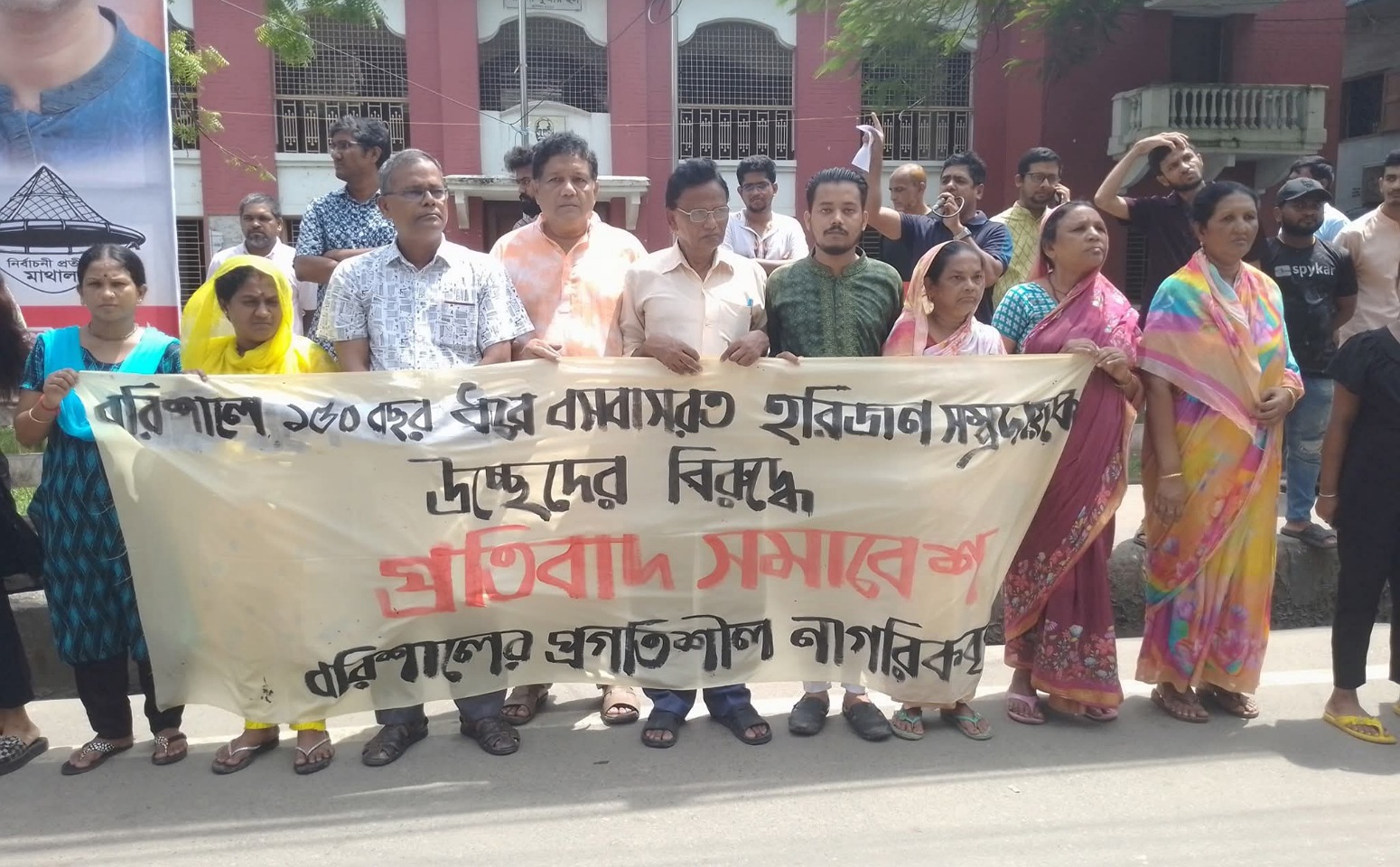
Hindu Voice Team: Barishal, Bangladesh – The air in Barishal city is tense. At the heart of the storm lies the Harijan Community, a marginalized Hindu group that has lived in their colony for more than 150 years. Today, they face eviction at the hands of the local administration—an act that community leaders and human rights activists describe as yet another link in the long chain of Hindu displacement in Bangladesh.
“This Colony is Our Life”
The Harijan Community, largely employed as cleaners and sanitation workers, has rejected the administration’s decision. Families poured into the streets in protest, holding placards and chanting slogans.
“We were brought here by the British from Andhra Pradesh. They gave our forefathers this land. Since then, generation after generation has lived and died here. This colony is not just brick and soil—it is our life. Evicting us without rehabilitation is like throwing us into the streets,” said one elderly community leader.
Mothers expressed fear of being rendered homeless, while youths worried that the eviction would destroy their only semblance of security. Many pointed out that their services keep the city functioning, yet they remain among the most neglected citizens of Bangladesh.
A Community at the Margins
The Harijans, often derogatorily referred to as “untouchables” in South Asia, have lived on the edges of society for centuries. In Bangladesh, they form one of the most marginalized groups—confined to sanitation work, denied opportunities, and often deprived of dignity. Their colony in Barishal is more than a residential space; it is a rare stronghold of their cultural identity and collective survival.
To them, the eviction order is not just an administrative act. It is a direct threat to their existence.
The Shrinking Hindu Population
The attempted eviction of the Harijans mirrors a broader and deeply troubling reality: the systematic decline of Hindus in Bangladesh.
At the time of Partition in 1947, Hindus made up about 21% of East Pakistan’s population.
By the 1971 Liberation War, the number had already dropped to around 14%, amid violence, displacement, and migration.
Today, Hindus constitute less than 7% of Bangladesh’s population.
Every decade has witnessed land seizures, targeted attacks, and forced migrations that hollowed out the Hindu demographic. For many, the Harijan colony eviction represents yet another deliberate step in this ongoing process.
Patterns of Dispossession
Historians and rights groups point to several waves of Hindu exodus:
Against this backdrop, the Barishal eviction is not an isolated event but part of a historical continuum.
Human Rights Concerns
Rights activists argue that forced eviction without rehabilitation violates international human rights standards. “The Harijan families are not encroachers. They are legal settlers with historical roots. Evicting them without a rehabilitation plan is state-sponsored marginalization,” said a Dhaka-based human rights lawyer.
The move is seen as both a humanitarian crisis and a political statement: minorities remain vulnerable, their security contingent on the whims of the administration.
Cultural Erasure in Motion
For the Harijans of Barishal, losing their colony would mean more than just losing homes. It would mean severing their last ties to ancestral heritage. “Our children will have no place to call their own. This is not just eviction—it is cultural erasure,” one protester remarked.
The incident is widely interpreted as a documented example of Hindu displacement in Bangladesh. Critics warn that if such policies continue, the already shrinking Hindu minority may one day vanish from the nation’s demographic fabric.
Conclusion: A Struggle for Survival
The Barishal eviction crisis is a microcosm of a larger tragedy—the slow, silent displacement of Hindus from Bangladesh. What began as a vibrant 21% community in 1947 has dwindled to a fragile minority struggling to survive.
The Harijan Community’s cry for rehabilitation is not just a demand for shelter. It is a desperate plea for dignity, recognition, and the right to exist in their homeland.
As the world watches, one question looms large: Will Bangladesh protect its minorities and their heritage, or will history record yet another chapter of erasure?